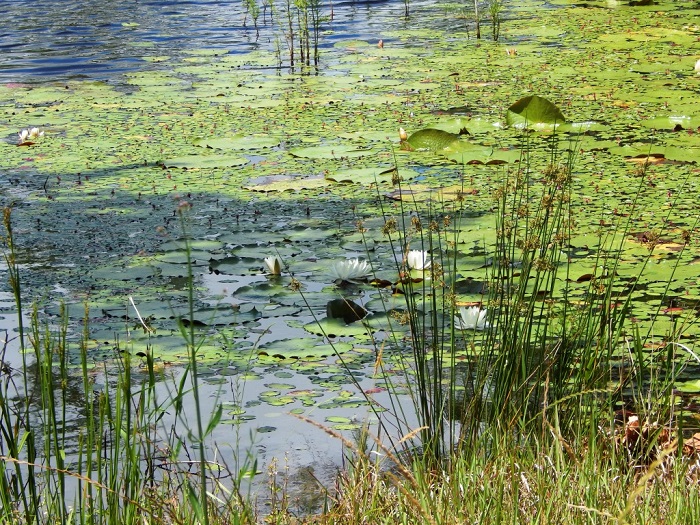
As water temperatures rise, aquatic weed growth increases. Be sure to monitor ponds closely and control weeds before the problem gets too large.
Photo Credit: Mark Mauldin
Similar to Goldilocks’ porridge, water temperature doesn’t need to be too hot or too cold, it needs to be just right for using aquatic herbicides (70o – 80o F). Here in Florida these optimum water temperatures occur in the spring. Water temperature largely regulates the growth of most aquatic weeds; cool temperatures slow or stop growth and warm temperatures promote growth. Keeping this simple principle in mind can help determine when to use aquatic herbicides.
Generally speaking, aquatic herbicides should not not used when water temperatures are below 60o F, because most aquatic weeds are not actively growing. For herbicides to be effective the target plants must be actively growing. Applying herbicides too early in the spring is generally not an issue because winter dieback can make many aquatic weeds hard to find when water temperatures are cool. The weeds are out of sight and out of mind. The much more common issue is waiting too long before attempting to control weeds.
As water temperatures climb above 60o weeds begin to grow. Unfortunately, they often grow unnoticed throughout the spring until they become completely out of control in the summer. By this point, control, even using herbicides, is a monumental task. If at all possible, control weeds early in the growing season.
As plants grow they are able to build up energy reserves, making them more difficult to control. The longer they are allowed to grow the stronger and more difficult they become to control. Controlling weeds earlier in the growing season eliminates this problem.
Similarly, as the growing season progresses plants produce more and more biomass. If a herbicide is applied and the weeds are killed, large amounts of decomposing plant material in the water can also cause problems. The decomposition process uses oxygen; dissolved oxygen can drop to levels that are hazardous to fish and other aquatic species. The more plant material that is present when herbicides are applied the bigger concern this becomes. This is the reason most herbicide labels recommend treating no more then 1/3 to 1/2 of the pond at one time. Applying herbicides earlier in the growing season, before large amounts of biomass are produced can help lessen this problem.

Large amounts of decaying plant material can deplete the dissolved oxygen in a pond. Be careful when controlling aquatic weeds, especially during the hot summer months.
Photo Credit: Mark Mauldin
Further compounding the issue, warm water is physically able to hold less dissolved oxygen than cooler water. Late in the summer, pond water can be very warm with low concentrations of dissolved oxygen even before large amounts of decomposing plant material are added.
To help reduce the risk of oxygen depletion never treat more than ½ of a pond at one time, if weed growth is already substantial treat no more than 1/3 of a pond at one time and always allow 10 -14 days for oxygen recovery between treatments. Also, avoid treating on cloudy days, another factor that can lead to lowered dissolved oxygen.
Aquatic weed control will be easier and more effective if you monitor your pond throughout the spring and make any needed herbicide applications early, before the weeds have grown too large and the water is too warm. Consult your county extension agent for assistance determining what aquatic weeds you have and if treatment is necessary. Always read and follow all label directions when using any herbicide.
- Fall is Here – It’s Time to Spray Cogongrass - October 11, 2024
- Considerations for Managing Weeds with Herbicides in Perennial Pastures and Hayfields - October 4, 2024
- Peanut Maturity Update – 9/19/24 - September 20, 2024
